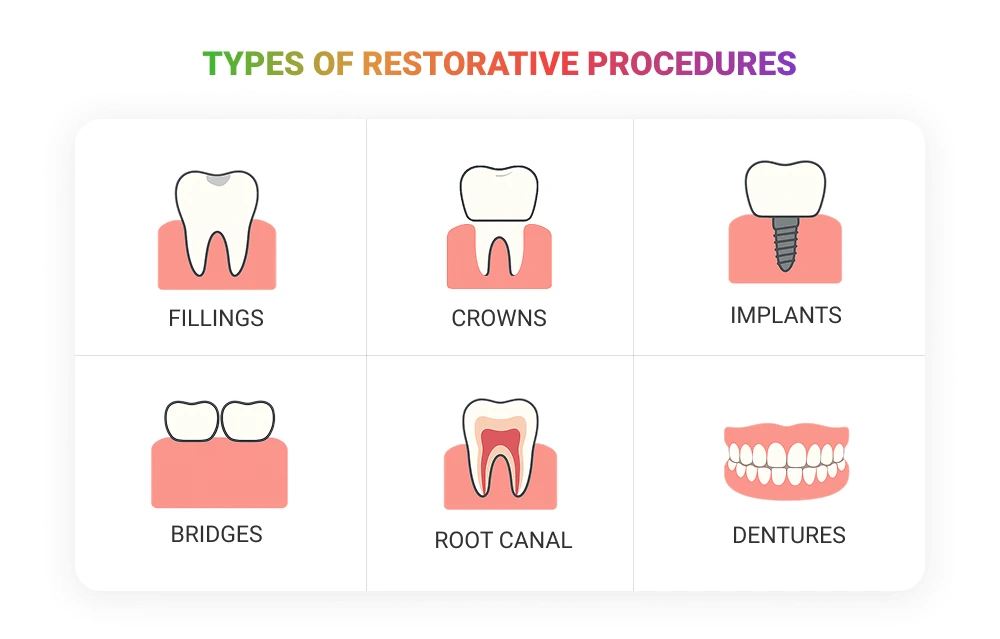Restorative Dentistry in Houston: Types & Procedures
15 Oct 2025
Restorative dentistry is a vital branch of dental care focused on restoring the function and aesthetics of teeth that have been damaged due to decay, injury, or wear.
This includes a variety of procedures designed to repair, rebuild, or replace teeth, ensuring that patients can enjoy optimal oral health and a confident smile.
Understanding the different types of restorative treatments available can empower individuals to make informed decisions about their dental care.
What Is Restorative Dentistry?

Restorative dentistry is not merely about fixing teeth; it is about improving overall oral health and quality of life for patients.
The primary goal is to restore the natural function of teeth, which can be compromised by various factors, including cavities, trauma, or age-related wear.
By addressing these issues, restorative dentistry helps individuals regain their ability to eat, speak, and smile without discomfort or embarrassment.
Importance of Restorative Dentistry
The significance of restorative dentistry extends beyond aesthetics.
A healthy mouth is crucial for overall well-being, as dental problems can lead to complications such as infections, difficulty in eating, and even systemic health issues.
Restorative dental procedures can prevent further deterioration of patients’ oral health and improve their quality of life.
Who Can Benefit?
Restorative dentistry is beneficial for individuals of all ages. Whether you are dealing with minor issues like cavities or more complex problems such as missing teeth, there are tailored solutions available.
Regular dental check-ups can help identify the need for restorative treatments early, ensuring that patients from Greenspoint to Westfield and beyond can enjoy optimal oral health and a confident smile.
Types of Restorative Procedures

Restorative dentistry encompasses a wide range of procedures, each designed to address specific dental concerns.
Below are some of the most common types of restorative treatments:
Dental Fillings
Dental fillings are one of the most frequently performed restorative procedures. They are used to treat cavities caused by tooth decay.
During this process, the dentist removes the decayed portion of the tooth and fills the cavity with a material, typically composite resin or amalgam.
- Benefits: Fillings help restore the tooth’s structure and prevent further decay. Modern materials can be color-matched to the natural teeth, making them aesthetically pleasing.
- Longevity: With proper care, fillings can last for many years, but regular dental visits are essential to monitor their condition.
Dental Crowns
Crowns, often referred to as caps, are used to cover and protect damaged or weakened teeth. They are particularly useful for teeth that have undergone significant decay or have been treated with root canal therapy.
- Materials: Crowns can be made from various materials, including porcelain, ceramic, metal, or a combination of these. The choice of material often depends on the location of the tooth and the patient’s aesthetic preferences.
- Procedure: The process typically requires two visits: one for tooth preparation and impression taking, and another for crown placement.
Dental Bridges
Bridges are a solution for replacing one or more missing teeth. They consist of artificial teeth (pontics) anchored to the adjacent natural teeth (abutments) using crowns.
- Types: There are several types of bridges, including traditional, cantilever, and Maryland bridges, each suited for different situations.
- Functionality: Bridges restore the ability to chew and speak properly while preventing the remaining teeth from shifting out of alignment.
Dental Implants
Dental implants are a revolutionary option for tooth replacement. They involve the surgical placement of a titanium post into the jawbone, which acts as a replacement root for a missing tooth.
Our patients from areas like Aldine and Spring often ask about implants after losing a tooth — and for good reason. From maintaining jawbone structure to looking and feeling natural, they go far beyond just aesthetics.
- Advantages: Implants provide a stable and long-lasting solution, preserving jawbone health and preventing facial structure changes that can occur with tooth loss.
- Process: The implant process involves multiple stages, including placement, healing, and the attachment of a crown or bridge.
Dentures
Dentures are removable appliances designed to replace missing teeth. They can be complete (for those missing all teeth in an arch) or partial (for those with some remaining natural teeth).
- Modern Options: Today’s dentures are more comfortable and natural-looking than ever, with options for implant-supported dentures that offer added stability.
- Care: Proper maintenance and regular dental visits are crucial for ensuring the longevity and effectiveness of dentures.
Inlays and Onlays
Inlays and onlays are conservative restorative options used when a tooth is too damaged for a filling but does not require a full crown.
- Inlays: These are used to fill the space within the cusps of a tooth.
- Onlays: These extend over one or more cusps, providing additional coverage and support.
Root Canal Therapy
Root canal therapy is necessary when decay reaches the inner pulp of a tooth, causing infection or severe pain.
- Procedure: The dentist removes the infected tissue, cleans the canal, and seals it with a biocompatible material. A crown is often placed afterward to restore the tooth’s strength.
- Misconceptions: Many people fear root canals, but they are typically comfortable and effective in preserving natural teeth.
Full Mouth Rehabilitation
Full mouth rehabilitation involves a comprehensive approach to restoring the function and aesthetics of the entire mouth. This may include a combination of various restorative procedures tailored to the patient’s specific needs.
- Assessment: A thorough evaluation is conducted to determine the best course of action, which may involve multiple specialists, including a periodontist and a denture specialist.
- Goals: The primary aim is to improve oral health, enhance functionality, and boost the patient’s confidence in their smile.
Gum and Periodontal Treatments
Healthy gums are the foundation of any successful dental restoration—and that’s where a periodontist comes in. These gum specialists play a critical role when bone loss, gum disease, or implant preparation is involved.
- Scaling and Root Planing: This deep cleaning procedure removes plaque and tartar from below the gumline, helping to prevent gum disease.
- Maintenance: Regular periodontal check-ups are crucial for monitoring gum health and preventing future issues.
The Role of Preventive Care

While restorative dentistry addresses existing problems, preventive care is essential for maintaining oral health and avoiding the need for extensive treatments in the future.
Importance of Regular Check-Ups
Routine dental visits allow for early detection of issues, enabling timely intervention. Dentists can identify potential problems before they escalate, saving patients time, money, and discomfort.
Home Care Practices
Good oral hygiene practices at home, including brushing, flossing, and using mouthwash, play a significant role in preventing dental issues. Educating patients about proper techniques can empower them to take charge of their oral health.
At The Root Of It
Restorative dentistry is a crucial aspect of dental care that focuses on repairing and improving the function and appearance of teeth. With a variety of procedures available, individuals can find tailored solutions to address their specific dental concerns.
With restorative treatments and preventive care, patients can take proactive steps toward achieving and maintaining optimal oral health.
Whether you need a simple filling or a comprehensive full mouth rehabilitation, consulting with a qualified dental professional can help you regain your smile and confidence.
If you are considering restorative dentistry, reach out to Greenspoint Dental to explore your options and take the first step toward a healthier, more vibrant smile.
Located just off Beltway 8 near Greenspoint Mall, Greenspoint Dental makes it easy for North Houston families to get the restorative care they need — without long commutes or referral headaches.
Related Blog Articles